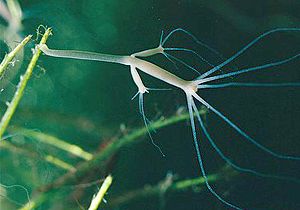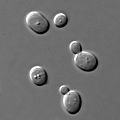Budding facts for kids

Budding is a cool way some living things make copies of themselves! It's a type of asexual reproduction, which means a new organism grows right on the side of its parent. Think of it like a tiny bump that gets bigger and bigger.
This new "bud" stays attached to the parent while it grows and develops. Once it's big enough and ready, it breaks off and becomes a completely separate, independent organism. Because it's asexual reproduction, the new organism is an exact copy, or clone, of its parent. It has the same genetic information!
Budding is very common in tiny organisms like yeast (which are a type of fungi) and also in some plants. You can even find it happening with some animals, like hydras and sponges.
Contents
What is Asexual Reproduction?
Asexual reproduction is a way for living things to make new individuals using only one parent. Unlike sexual reproduction, where two parents combine their genetic material, asexual reproduction means the offspring gets all its genes from just one parent. This makes the new organism genetically identical to the parent, like a perfect copy!
This method is super efficient because it doesn't need a partner. It can also be very fast, allowing organisms to multiply quickly when conditions are good. However, because there's no mixing of genes, all the offspring are the same. This can be a problem if the environment changes, as they might all be affected in the same way.
How Budding Works in Yeast
Tiny Factories: Yeast Budding

One of the most famous examples of budding happens with yeast. Yeast are single-celled fungi, so tiny you need a microscope to see them! They are often used to make bread rise and to brew drinks.
When a yeast cell is ready to reproduce, a small bulge forms on its surface. This bulge is the new "bud." The parent cell then copies its DNA (its genetic instructions) and sends one copy into the growing bud. The bud continues to grow, getting bigger and bigger, while still attached to the parent cell.
Once the bud is fully grown, a wall forms between the new cell and the parent cell. Then, the new yeast cell breaks away, becoming an independent organism. Sometimes, before the first bud breaks off, the parent cell might even start making another bud! This allows yeast to multiply very quickly.
Budding in Animals: The Hydra Example
Growing a New Body: Hydra Budding
While less common in complex animals, budding is a fascinating process for simpler creatures like hydras. A hydra is a tiny freshwater animal that looks a bit like a small tube with tentacles at one end. They usually attach themselves to rocks or plants in the water.
When a hydra wants to reproduce by budding, a small bump starts to grow on its side. This bump is a group of cells that begin to divide and specialize. As the bud grows, it starts to develop all the parts of a tiny new hydra, including its own mouth and tentacles.
The new hydra continues to grow while still attached to the parent. It even starts to feed itself using its own tentacles! Once it's fully developed and strong enough, it detaches from the parent hydra and floats away to live on its own. It's just like a mini-version of the original hydra.
Other Organisms That Bud
Besides yeast and hydras, other organisms also use budding. Some types of sponges, which are simple aquatic animals, can reproduce this way. Even some plants can show forms of budding, though it might look a bit different from the process in yeast or hydras. For example, some plants can grow small plantlets on their leaves or stems that eventually drop off and grow into new plants.
Images for kids
-
Saccharomyces cerevisiae reproducing by budding
See also
 In Spanish: Gemación para niños
In Spanish: Gemación para niños


